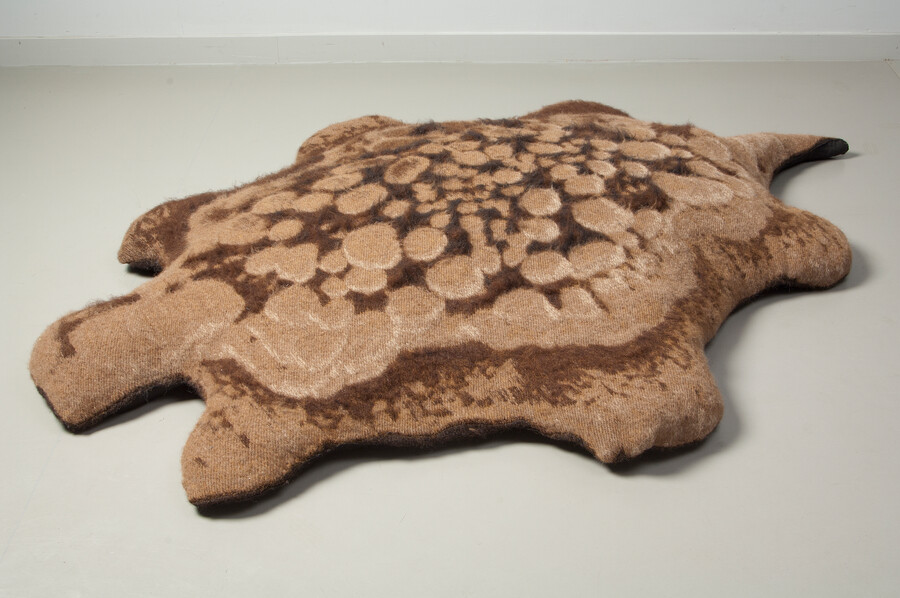Fifteen years ago, Borre Akkersdijk worked in the TextielLab for the first time. Now he has his own high-tech knitting workshop in Amsterdam, where he uses the latest machines from Stoll, Santoni and Mayer & Cie in unprecedented ways. “Without those first years at the TextielLab, I wouldn’t be where I am today.”
Borre Akkersdijk’s first encounter with the machines in the TextielLab took place when he was still studying at the Design Academy Eindhoven. Back then, his work at the academy caught the eye of guest lecturer Maarten Baas. When the museum asked Baas to take on a collection assignment, he asked Akkersdijk to join him. “Maarten didn’t really make soft things, and I was working on a very tactile textile project. Together, they developed ‘Animal Skin’ in the lab in 2007: double-woven rugs made from the thickest possible yarns such as mohair and alpaca. It marked the beginning of a five-year period in which Akkersdijk kept returning to Tilburg to develop what he had discovered in previous visits. He was so fascinated by the thickening of fabrics on the machine that he devoted his graduation project to it. This endeavour started at textile manufacturer Innofa, but when the machines there were needed for a commercial order four weeks before his graduation he relocated to the TextielLab. Here he worked with product developers on ‘Ready-Made’, a collection of filled fabrics created with the weaving and knitting machine as ready-made pattern pieces. “I wanted to integrate the final product and the production process so that the DNA – the shape of the garment – is already there when it comes from the machine.”

Collection assignment
The collaboration went well and after his graduation, he was approached by the museum for a collection assignment. He continued with the concept of thickening fabrics, and switched from jacquard weaving to knitting. Akkersdijk wanted to make fashion items with stuffed mattress fabrics. He met knitting experts Jan-Willem Smeulders and Huub Waulthers who wound up being excellent team members. “Jan-Willem was an expert in mattress technology and had a good feel for what I needed, I learned a lot from him. In the process, I got a better understanding of how knitting machine software works, which yarn you need and which scales you need to work with. In other words: what you need to provide the machine with for it to deliver the desired product. To achieve what I wanted, we adapted the circular knitting machine and hacked into the software. Of course, it is quite remarkable that this was possible.” By collaboratively pushing the limits of the machines, we managed to develop a new technique for fashion in which the bottom, top and filling come off the machine in one go, with a thin edge for stitching.
“Without those first years at the TextielLab, I wouldn’t be where I am today.”
Endless patience
Akkersdijk: “What was so wonderful about my time at the TextielLab was the endless patience of the technical people who helped me. Trying to make the impossible possible. And if it didn’t work out, continuing via a different route. The mindset was always: let’s give it a shot. We’ve never done it before, so let’s try. That has been extremely valuable for me. It gave me a lot of freedom and allowed me to develop a completely different aesthetic for clothing.” The freedom Akkersdijk had in the lab allowed him to develop his first real clothing collection using the mattress technique; this gave him a solid portfolio to show the world. The fact that the TextielMuseum exhibited the pieces helped: “Once your work is exhibited in a museum, suddenly it’s validated and you matter.” It was a good base for taking it to Paris Fashion Week and then Amsterdam Fashion Week as well.”
Open source
He soon returned for a second collection, this time on his own initiative. “As a recently graduated designer, the TextielLab was the ideal place for me to experiment with materials and techniques. That’s something unique; you can’t just walk into a factory and start testing.” Meanwhile, closer to home, in Amsterdam, he has set up BYBORRE knitting lab. “With this, I continue where the TextielLab leaves off. They do not produce for the industry. We start with small runs but also scale them up – along with the customer. I want to work more with the industry so that we can innovate together. It would be nice to make this closed world more transparent and to work more open-source. That is why we have also developed a package of design software: BYBORRE Create. With it, all makers can create their own textiles on the circular knitting machine via an online editor, an accessible tool that makes a complex production process accessible and democratic. I deeply believe in more democratic ways of creating, so we can all grow together.”